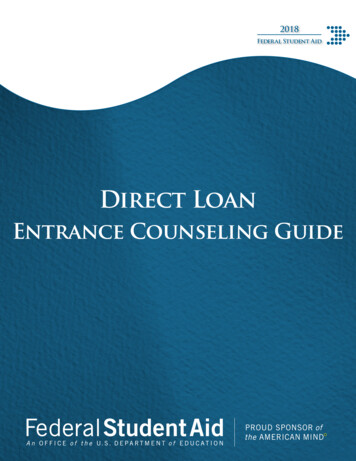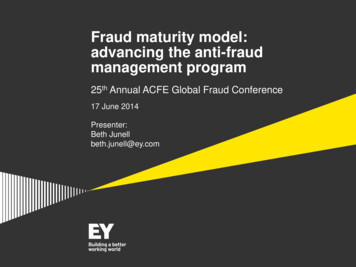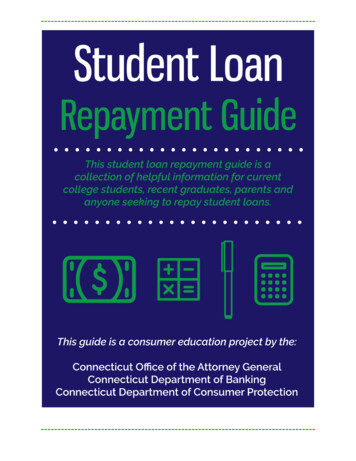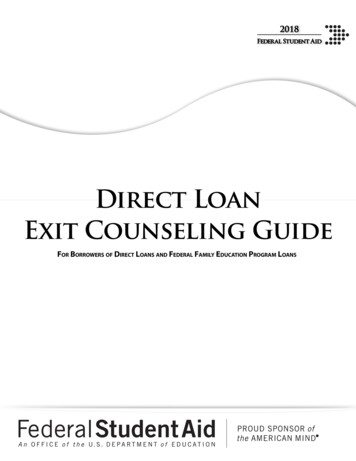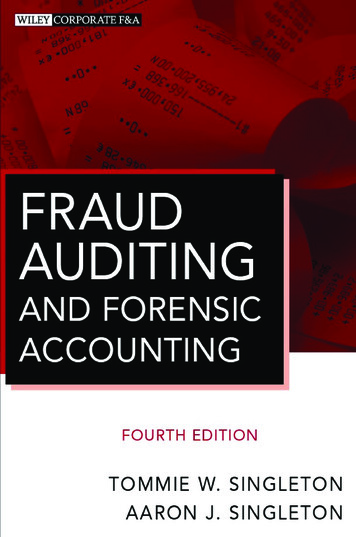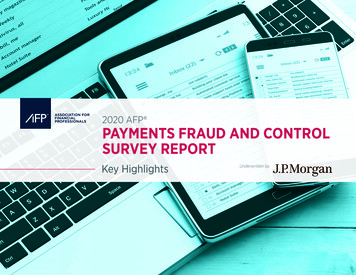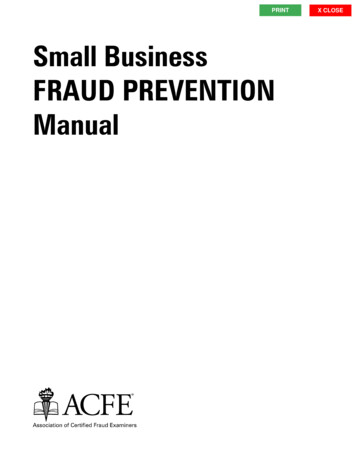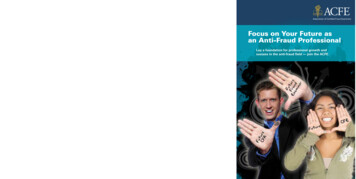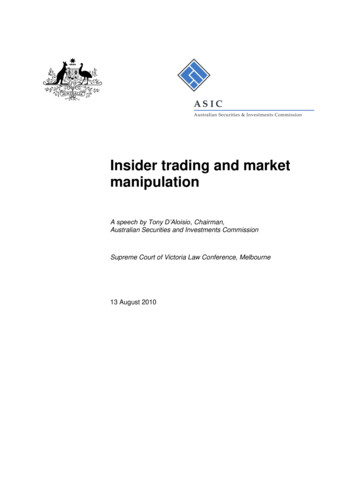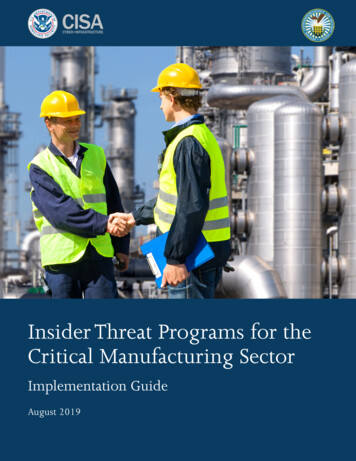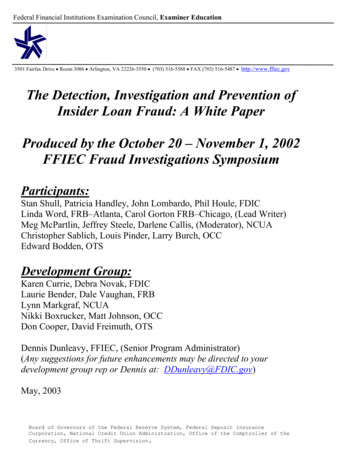
Transcription
Federal Financial Institutions Examination Council, Examiner Education3501 Fairfax Drive Room 3086 Arlington, VA 22226-3550 (703) 516-5588 FAX (703) 516-5487 http://www.ffiec.govThe Detection, Investigation and Prevention ofInsider Loan Fraud: A White PaperProduced by the October 20 – November 1, 2002FFIEC Fraud Investigations SymposiumParticipants:Stan Shull, Patricia Handley, John Lombardo, Phil Houle, FDICLinda Word, FRB–Atlanta, Carol Gorton FRB–Chicago, (Lead Writer)Meg McPartlin, Jeffrey Steele, Darlene Callis, (Moderator), NCUAChristopher Sablich, Louis Pinder, Larry Burch, OCCEdward Bodden, OTSDevelopment Group:Karen Currie, Debra Novak, FDICLaurie Bender, Dale Vaughan, FRBLynn Markgraf, NCUANikki Boxrucker, Matt Johnson, OCCDon Cooper, David Freimuth, OTSDennis Dunleavy, FFIEC, (Senior Program Administrator)(Any suggestions for future enhancements may be directed to yourdevelopment group rep or Dennis at: DDunleavy@FDIC.gov)May, 2003Board of Governors of the Federal Reserve System, Federal Deposit InsuranceCorporation, National Credit Union Administration, Office of the Comptroller of theCurrency, Office of Thrift Supervision.
INSIDER LOAN FRAUDTABLE OF CONTENTSIntroductionFactors Conducive to FraudExamples of Insider Loan Fraud112Control Environment Assessment345677Insider Loan Fraud Detection8910101011Code of ConductEmployment PracticesIndependent Loan ReviewAuditInternal ControlsAnalysis of Electronic Loan DataBoard of Directors Minutes and ReportsDiscussions with EmployeesInsider and Borrower Financial Statement AnalysisLoan File ReviewResearching Suspicious xAppendixAppendixABCDEFG111214Control Environment Assessment Quick ReferenceDetectable Warning SignsResearch ProceduresLoan Tracing Procedure DetailSummary Case MemoFlowchart SamplePublic Websites118193236373839
INSIDER LOAN FRAUDFraud poses substantial risks, both to individualinstitutions and the financial system. This interagency guidancefocuses on insider1 loan fraud and ways that financialinstitution examiners can identify, research, and documentsuspected activities. Though intended to heighten examiners’awareness and encourage flexible approaches to this problem,direction provided herein is not meant to over-ride or replacecurrent examination policies and practices. Examiners shouldonly use these procedures contained in this document when warningsigns that warrant expanded procedures are present and inconsultation with their supervisors.The initial narrative portion discusses various issuesrelated to prevention, detection, and documentation. Inaddition, a series of appendices contain warnings signs,procedures and other guidance designed to be separated forexaminer use. The first narrative section, Control EnvironmentAssessment, concentrates on infrastructure that reduces the riskof insider loan fraud. The second portion, Insider Loan FraudDetection, identifies avenues of review that might revealanomalous items requiring additional research. The last section,Researching Suspicious Circumstances, while discussing theimportance of additional procedures, also highlights the criticalnature of interviewing skills and appropriate documentation. Theassociated Appendices include an inventory of warning-signsspecific to insider loan fraud and a group of procedures that canbe used to research suspected activities, as well as otherreference materials. Examiners should use these appendices inconjunction with the applicable narrative sections and inconsultation with their supervisors.Factors Conducive to FraudFraud is often defined as: “[a] knowing misrepresentationof the truth or concealment of a material fact to induce anotherto act to his or her detriment.”2 There are several commonpsychological and environmental conditions that foster theoccurrence of fraud. The fundamental element that must exist isawareness of a control weakness that can be exploited forfinancial gain. Further, whether committed individually or incollusion, fraud frequently arises when an instigator(s) developsa financial need that he or she cannot share with anyone.Examples include addictive behaviors, family medical problems,romantic entanglements, financial hardships, or similar1The term “insider” is intended to mean an institution-affiliated party, such as anofficer, director, employee, agent, consultant or any other person who participates inthe affairs of a financial institution.2Black’s Law Dictionary p. 670 (7th ed. 1999).1
situations. Finally, the instigator(s) develops arationalization that makes the act acceptable in his or herpersonal ethical code.Since the tone set by executive management tends topermeate the entire organization, a strong ethical tenor at thetop of an organization will help establish a principled attitudethroughout. Absent that, it is not unusual for lower levelemployees to follow the lead of any top managers who may beengaging in fraud or perceived as such. Even without illegalactivity at the top, lax management and weak internal controlscan produce a similar effect.Environmental aspects such as weak internal controls and aninadequate audit program present the motivated insider with theopportunity to engage in improper behavior. Active, strongcontrols reduce the opportunities available to those who findthemselves in the circumstances referred to above. In theabsence of a satisfactory control environment, the followingelements can help to counter-balance structural deficiencies: Increased attention to an institution’s operations andstaff when examiners are on-site,A skeptical attitude on the part of examiners and auditorsgeared toward early fraud detection, before the level ofdamage imperils an institution, andVisible, credible adverse consequences, such as a highprobability of detection, administrative enforcement, andcriminal prosecution.Examples of Insider Loan FraudThe following list, while not all-inclusive, illustratesvarious insider loan fraud situations typically found infinancial institutions: Nominee loans4 and similar transactions that are constructedto circumvent laws, regulations, and institutions’ internallimits or internal policies;Conflicts-of-interest that go beyond laws governing insiderinterests;Bribes and kickbacks arising from lending activities;Loans tied to favors for friends and family, including nonmonetary consideration;Fictitious loans;4A “nominee loan” is one in which the borrower named in the loan documents is not thereal party in interest, i.e., the party that receives the use or benefit of the loanproceeds.2
Manipulation in the sale and purchase of loan pools,OREO sold through preferential contracts that includefavorable financing or are not at arms length,Inappropriate or fraudulent loan arrangements used topurchase capital stock, which inflates the capital base.When insider loan fraud does occur, the federal regulatoryagencies may be able to penalize the offender, protect thefinancial system from the offender, and deter similar offences byother insiders by pursuing civil enforcement action. Theagencies may have the authority to pursue certain enforcementactions against an insider who has committed loan fraud,regardless of whether the insider is criminally prosecuted.These possible actions include assessing civil money penalties;ordering insiders to reimburse, make restitution or indemnifylosses; or prohibiting insiders from participating in the affairsof insured institutions.CONTROL ENVIRONMENT ASSESSMENTInsider loan fraud prevention, like other forms of fraudprevention, is a frame of mind. An institution’s controlenvironment, including management’s attitude, may contributesignificantly to windows of opportunity for insiders to commitloan fraud. Not only do control weaknesses provide theopportunity for an insider to commit loan fraud; some insidersmay even seek out weaknesses to exploit. Examiners andinstitution management should be alert to all possibilities.The control environment should be examined with healthyskepticism. Different facets of the institution’s structure andculture should be examined using your agency’s risk assessmentapproach to examinations. Certain tools can be used to determineif windows of opportunity are open and to determine the need foradditional resources and time to be allocated to an on-siteexamination to help close these windows.Although it is not possible to avoid all instances ofinsider loan fraud, financial institutions can better manage suchrisk by creating a control environment that promotes honest andopen corporate behavior. It is far more cost effective toprevent insider loan frauds than to investigate and prosecutethem. A strong control environment hinders an insider fromdominating the institution and circumventing restrictions.Strong employment practices prevent people with questionablereputations from entering the financial services industry.Essential elements of a strong control environment include codeof conduct, employment practices, loan review system, independentaudit, and internal controls.3
Code of ConductAn essential preventive element against insider loan fraudis a clear statement by the institution’s board of directors ofits ethical position, such as a code of business principles.5 Acode of conduct, which is expressed strongly and appliedvigorously, gives all employees a way to resolve ethicalconflicts and positions the institution as one that does businessfairly and honestly. Compliance must include the entireinstitution: directors, management, employees, and institutionaffiliated parties. The code of conduct should be impartiallyenforced and include sanctions.People have a tendency to view fraud as a crime which iscommitted by outsiders rather than intimates. As a result,insider loan fraud is sometimes not fully considered in thedevelopment and enforcement of codes of conduct and businessprinciples. It can be seen by management as a negative featurein a code extolling positive corporate principles such asteamwork, trust, and respect. Ignoring this potential risk is alost opportunity. Financial institutions, which successfullypromote high standards of ethical conduct in all situations, havea lower incidence of fraud and find out about incidents earlier.Consider the following questions when assessing theadequacy of an institution’s code of conduct: Does the code of conduct address conflicts of interest andself-dealing that could lead to fraud? Does the code of conduct define acceptable behavior, encourageethical conduct, and establish mechanisms to monitor andenforce the policy? Does the institution have a system to validate compliance withits code of conduct? Does the institution have an ongoing program to educate andraise the awareness of the entire institution regarding itscode of conduct? Does the institution provide an independent avenue, such as awhistle blower policy, for reporting suspicious activitydirectly to the board of directors?5Refer to agency guidelines for specific guidance regarding appropriate code of conductand conflicts of interest policies.4
Does the code of conduct or loan policy define the term“related interests” and include provisions for properdisclosure of all related interests?Employment PracticesAn essential defense against insider loan fraud is the useof proactive hiring procedures. Employees engaging in fraudsoften fit a profile. As stated earlier, they may be involvedwith drugs, alcohol, gaming, or personal relationships creatingextraordinary financial needs, or may be experiencing personalfinancial hardships that are otherwise unknown to their employer.Ongoing monitoring and awareness of all employees’immediate situational factors is essential. Many of the mostscandalous insider loan frauds have been generated by persons of“impeccable” social background with no previous record ofdishonesty. In essence, this lack of a prior history of insiderabuse and self-dealing led to a false sense of security andcontributed to the ability of such insiders to participate inlarge frauds.Consider the following questions when determining whetheran institution’s employment practices are proactive deterrentsfor insider loan fraud: Are comprehensive background checks performed for all newpersonnel, including directors? While such a program shouldbe tailored to the size and complexity of the institution, theprotocol could include evaluation of handwriting andfingerprint samples by law enforcement authorities,verification of educational transcripts, analysis of creditreports, reference validation, and public records searches?Institutions should ensure legal requirements for above items,such as credit reports, are observed. Are there procedures in place to check employment referenceswith other financial institutions with respect to prospectiveemployee’s suitability? For example, are references reviewedto determine if there has been involvement in potentiallyunlawful activities? (Section 355 of the USA Patriot Act). Are there appropriate procedures to ensure that theinstitution has an ongoing screening program to monitor anddetect changes in its employees’ and directors’ lifestyles,behaviors, and actions? Do these procedures include periodiccredit reports and public records searches?The extent to which employment practices are implementedmay differ due to the size and complexity of the institution;5
however, compensating controls should be in place. Examples ofcompensating controls could include some of the following: Periodically reviewing the financial statements and taxreturns of insiders with outstanding loans, Reviewing an annual questionnaire in which insiders identifytheir related interests, and Reviewing insiders’ deposit and loan accounts on a routinebasis to determine the reasonableness of transactions.Independent Loan ReviewThe complexity and scope of a loan review system will varybased on an institution's size, type of operations, andmanagement practices. However, an effective loan review functioncan expose insider loan fraud and self-dealings at an earlystage.Consider the following questions when trying to determinethe effectiveness of an institution’s loan review system relativeto insider loan fraud: Is the loan review function independent of the creditadministration and loan approval processes? Are loan reviewfindings reported directly to the board of directors or boardlevel committee? Are procedures in place to review insider loans within areasonable time period after origination? Is the loan review timely, thorough, and comprehensive? Doesit ensure that loan samples include loans originated by alllending officers and is representative of all lending types? Are procedures in place to ensure the prompt identification ofloans with well-defined weaknesses and relevant lendingpatterns that may potentially be indicative of fictitious orfraudulent activity? Are procedures in place to identify multiple extensions,renewals, or rewrites that are exceptions to policy? Are procedures in place to assess the adequacy of andadherence to established lending and conflict of interestpolicies? Does loan review substantiate appraisal values for real estateproperties and make adequate reviews of appraisals?6
Do loan review personnel have the knowledge and confidence tochallenge transactions that look suspicious, especially if thetransactions have been executed by an executive officer orboard member?AuditDeterring dishonest insider lending practices may beachieved by increasing an insider’s perception of the risk ofcredible adverse consequences – namely, detection andprosecution. A comprehensive independent audit function providesa significant deterrent on both accounts. The institution shouldhave a reliable accounting function and internal control system,as well as an appropriately staffed audit function that hassufficient authority and resources to perform its function. Theaudit function should be independent and report findings directlyto the board of directors.Consider the following questions when assessing theadequacy of an institution’s audit function as a viable deterrentagainst insider loan fraud: Does the scope of the audit include review of compliance withthe code of conduct, employment practices, loan reviewsystems, and internal controls? Are there specific audit procedures to target insider loanfraud? Are confirmations of loan balances performed frequently enoughwith proper controls? Does the audit include a review of general ledger suspenseaccounts, such as loans in process; employee accounts andother transactions, such as wires, performed by employees; andcharged-off loans for insider involvement? Are auditors willing to challenge any transaction that lookssuspicious, especially those involving an executive officer orboard member?Internal ControlsThe potential for insider loan fraud is greatly increasedin an environment where internal controls are lax, arbitrary, ornon-existent; where management and others are exempt from policyand procedures; where nepotism is allowed but not acknowledged;and where the authority to act does not accompany responsibilityfor results.7
Consider the following issues when assessing theeffectiveness of an institution’s internal control system: Does the institution perform a risk assessment relative toinsider loan fraud? Are anti-fraud policies and procedures ineffect? Does the institution routinely assess the effectiveness ofcontrols with the ultimate test: would its system of checksand balances identify actions of a dishonest insidercommitting loan fraud? Does the institution’s control environment and organizationalstructure allow one employee or director to dominate orundermine lending decisions, or dominate senior management andthe board? Does the institution require rotation of duties and scheduleswithout notice? Is there sufficient segregation of duties? It should not bepossible for a single individual to complete all aspects of atransaction. Authorization for a transaction, custody of theasset, and ability to effect accounting entries should not beconcentrated in one person. Is the institution’s vacation policy strictly enforced for allemployees? What are the consequences of policy violations? Does the board monitor and supervise the actions of theinstitution’s loan officers to determine that they areexecuting their duties and loan authority in accordance withthe loan policy and delegations of authority granted by theboard?To summarize, as examiners assess the complete controlenvironment in relation to insider loan fraud, a “no” answer toany of these questions indicates that the institution may have aheightened exposure to insider loan fraud. Although not acertainty, a negative response to a single issue is a window ofopportunity for insider self-dealing, abuse, or fraud. A onepage recap of the above tips is provided in Appendix A fordetachment and use in the field. In addition, many of theseconcepts can be applied to the detection, not just the preventionof insider loan fraud.INSIDER LOAN FRAUD DETECTIONExperience and common sense are key elements in theidentification of potential insider loan fraud. If something8
does not look right or does not seem to make sense, furtheranalysis is usually needed. In addition, communicating yourconcerns to the examiner-in-charge early on is critical toalerting other examiners to look for similar patterns orcircumstances.This section identifies common sources of information thatmay contain warning signs of possible insider loan fraud. Inreviewing documentation from these sources, examiners need to bemindful of the ease with which fraudulent documents can becreated. Photocopies may not be representative of the originaldocuments. Inconsistencies between what should be identicalinformation contained in one document and another may indicatethat one, or both, of the documents may be forgeries. Theexaminer should always request original documents in thesesituations.The following are examples of instances where examinersdiscovered information that did not seem to make sense, and theirperseverance uncovered material insider loan frauds. Over a three-year period, an institution’s quarter-end pastdue loan ratio was consistently around one percent. Closerreview by examiners revealed that the chief executive officerwas refinancing loans and extending loan payments to maintaina low past due loan ratio. While reviewing a loan trial balance, an examiner noticedseveral real estate secured loans to different borrowers onthe same street with consecutive house numbers. The examineralso noticed that the loan balances did not appear to beamortizing.Research of public records disclosed that theborrowers did not own the real estate pledged as collateral.These are just a couple examples of examiners taking a step backand looking at the big picture to see if things just make sense.Analysis of Electronic Loan DataIt is common practice for financial institutions to provideregulators with an electronic download of the institution’s loandata, which is used primarily to determine the loan review scopefor an examination. Many of the data fields contain informationthat, when properly analyzed, may be early indicators forpotential insider loan fraud. Often the data is in a spreadsheetformat, which enables examiners to perform calculations and datasorts.Although the guidelines in Appendix B are based on datafields that are common to loan processing systems, not allinstitutions will maintain each of the data fields discussed9
below. In those instances, and especially where insider loanfraud is suspected, examiners should consider alternativeinformation sources such as reviewing system generated reports.Board Minutes and Board ReportsThe content and informative value of board of directors’minutes and board level reports varies from institution toinstitution. It is just as common for some institutions tomaintain detailed board minutes as it is for others to recordonly basic information. Management may be able to successfullyconceal indications of fraud by generating voluminous boardpackages rife with minute detail as easily as by omitting keyinformation. Board reports should be reviewed carefully todetermine the accuracy, adequacy, and appropriateness ofinformation reported to the directorate.Discussions with EmployeesFormal and casual discussions with employees may revealirregularities, anomalies, or suspicious behavior. Employees whoare very guarded in answering examiner questions may havesomething to hide. They may have personal knowledge ofquestionable loan transactions and are looking for an opportunityto inform examiners. Some employees may seek out examiners withknown situations. Other employees may unknowingly revealinformation through casual discussion that should be pursued byexaminers. An additional discussion of interviewing is includedin the section - RESEARCHING SUSPICIOUS CIRCUMSTANCES.Insider and Borrower Financial Statement AnalysisAnalysis of insiders’ and borrowers’ financial statementscan reveal several points of interest. Statements that containaccumulated assets or liabilities that are in excess of aninsider’s income generation capabilities can be a significantindicator of suspicious activity. Additionally, review of aborrower’s financial statements can reveal borrowing or businessrelationships between an insider and other institution customers.It is important that a institution’s internal analysis ofinsider financial statements occur in the ordinary course ofbusiness under the established credit granting regimen. Thiswould include verification of assets and liabilities,particularly if the financials are unaudited. Lack ofverification of financial statement items can be a warning signthat merits further examiner review.\10
Loan File ReviewIf warning signs are present, examiner loan file reviewshould include a review of the financial institution’s policiesand procedures, loan files, and committee minutes to determineexistence of anomalies. A synopsis of key policy parametersprepared by a member of the examination team can aid file reviewexaminers by providing a ready reference for assessing policycompliance. Inconsistencies with policies and procedures shouldtrigger more intense scrutiny.In summary, suspicion of insider loan fraud may arise froma variety of sources or from a just single source. The key is toquestion inconsistencies or information that does not make senseuntil the issues are resolved. Researching issues can beaccomplished through a number of avenues that are discussed inthe following section. A detailed list of warning signs isprovided in Appendix B.RESEARCHING SUSPICIOUS CIRCUMSTANCESStandard examination procedures are not designed to testroutinely for fraud, particularly in a risk-focused environment.This section and related appendices provide possible proceduresto use when examiners suspect insider abuse or fraud, as well asguidance for interviewing and documenting findings. Some ofthese procedures include tracing loan payments and proceeds,reviewing insiders’ deposit account activity, analyzing generalledger reconcilements and suspense account activity, andresearching public records for relevant information. Tracing loan payments and proceeds can provide details on thetransaction originator(s) or identify additional participants,as well as reveal the path of funding flows, and the finaldestination of funds. This information can be used tosubstantiate evidence of intentional misconduct. Reviewing insiders’ deposit account activity and officialchecks can also help establish the flow of funds; identifypreviously unknown, related parties to transactions; accountsat other institutions; and other lending relationships, Review and tracing of reconciling items can reveal items thatare not cleared properly or are re-aged to hideirregularities. Fraudulent lending activity is sometimeshidden in reconciling items of general ledger accounts. Researching public records will supply a wide variety ofinformation related to lien filings, ownership of assets,11
relationship of different parties, previously unidentifiedrelated interests, etc.A more extensive list of potential procedures is providedin Appendices C and D, which can be detached for field use.These are not intended to be all-inclusive, but rather aredesigned to stimulate the thought process about procedures thatcan be applied depending on the circumstances. Furthermore, eachof these steps would not be appropriate in all instances. Thenature of the suspected fraud will dictate the avenue of inquiry.Many of these items can also be used in detection of fraud.If a special inquiry appears to be indicated, examinersshould consult with their supervisors, fraud specialists, subjectmatter specialists, and legal staff in planning and executingfraud detection or research procedures. The review should beconducted in an objective manner and proceed in a way that doesnot raise the defenses of the insider(s). It is important toproceed in a way that does not reveal the examiner’s suspicionstoo early, as the insider may destroy records to protect his orher position. It is usually desirable to request a larger groupof records than the specific documents that may reveal theprecise fraud. This puts the evaluation in a broader context andhelps cover the anti-fraud purpose of the review. The examinershould also carefully consider the timing as to when the antifraud purpose of the review is revealed. Generally, the examinershould wait until all applicable records have been obtained andcopied or until all leads have been exhausted with no furtheravenues to pursue before discussions with personnel.In addition, examiners may consider other actions tofollow-up on suspected insider loan fraud. For instance, inaccordance with the agency’s policies and procedures, theexaminer may recommend the issuance of an order of investigation.The order of investigation empowers the agency to issue subpoenasand take depositions. This provides a means of obtainingevidence from sources that are outside of the institution.Another option to consider is a recommendation that theinstitution engage a third party to investigate the suspectedoffenses, such as a financial institution consultant, forensicaccountant, or private investigator.InterviewingInformation gathering through discussion or interview is astandard examiner tool employed on every examination. Whileinterviews conducted when fraud is suspected contain some of thesame methods employed in standard examinations, additionaltechniques are necessary for maximum effectiveness. The natureof the interview is different and a more tactical approach isnecessary. An examiner should not conduct these types of12
interviews alone, but should take another examiner as a witnessand to help with taking notes.Since preparation is critical to success, it is importantfor the interviewer to review existing documents and knowninformation. Initially, the examiner should determine theinformation he or she needs to have from the interview. Astrategy needs to be developed that leads the interview fromgeneral information toward the specific details that the examinerneeds to reveal. It is important not to script the interviewwith specific questions, but rely on a list of key discussionpoints. The interviewer needs to ensure that the interviewsubject does not glean too much information from the nature ofthe questions asked and discern the purpose of the interview tooearly.A good interviewer needs to be skilled at human interactionand able to easily establish rapport in the interview. Effortsshould revolve around setting the interviewee at ease and makinghim or her feel comfortable about volunteering information.Helpful techniques include conducting the interview in aninformal manner without the use of accusatory language. It isimportant that the interviewee not feel at ris
Institutions should ensure legal requirements for above items, such as credit reports, are observed. Are there procedures in place to check employment references with other financial institutions with respect to prospective employee's suitability? For example, are references reviewed to determine if there has been involvement in potentially
